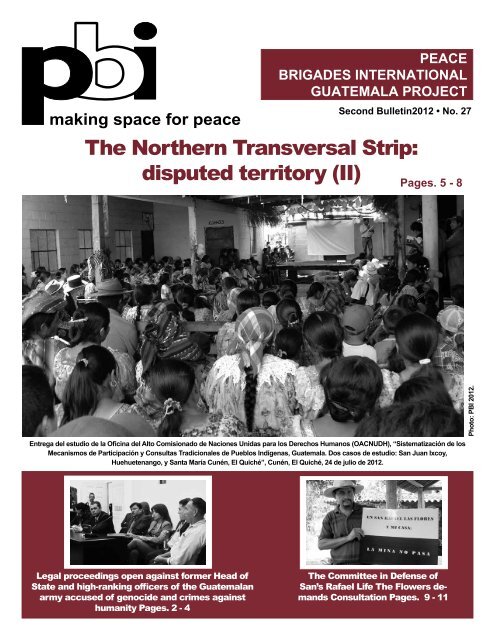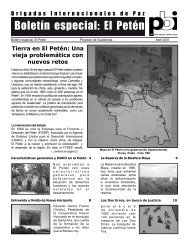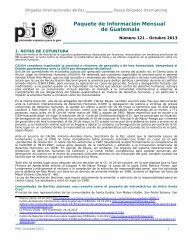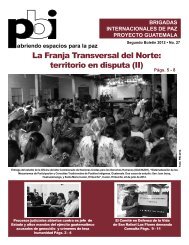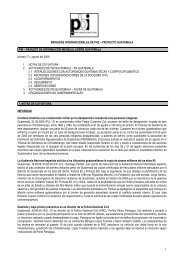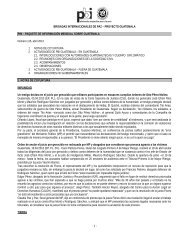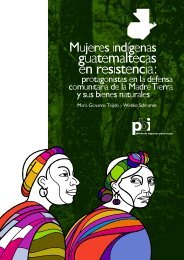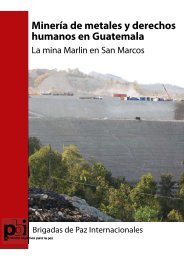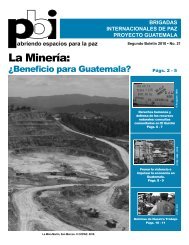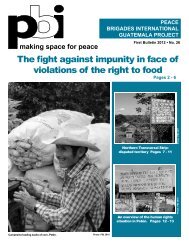The Northern Transversal Strip disputed territory (II) Photo
Bulletin 27 - 2nd of 2012 (pdf 1.4 MB) - PBI
Bulletin 27 - 2nd of 2012 (pdf 1.4 MB) - PBI
Create successful ePaper yourself
Turn your PDF publications into a flip-book with our unique Google optimized e-Paper software.
Second Bulletin2012 • No. 27<br />
<strong>The</strong> <strong>Northern</strong> <strong>Transversal</strong> <strong>Strip</strong>:<br />
<strong>disputed</strong> <strong>territory</strong> (<strong>II</strong>)<br />
Pages. 5 - 8<br />
Entrega del estudio de la Oficina del Alto Comisionado de Naciones Unidas para los Derechos Humanos (OACNUDH), “Sistematización de los<br />
Mecanismos de Participación y Consultas Tradicionales de Pueblos Indígenas, Guatemala. Dos casos de estudio: San Juan Ixcoy,<br />
Huehuetenango, y Santa María Cunén, El Quiché”, Cunén, El Quiché, 24 de julio de 2012.<br />
<strong>Photo</strong>: PBI 2012.<br />
Legal proceedings open against former Head of<br />
State and high-ranking officers of the Guatemalan<br />
army accused of genocide and crimes against<br />
humanity Pages. 2 - 4<br />
<strong>The</strong> Committee in Defense of<br />
San’s Rafael Life <strong>The</strong> Flowers demands<br />
Consultation Pages. 9 - 11
PEACE BRIGADES INTERNATIONAL<br />
Brigadas Internacionales de Paz<br />
Legal proceedings open against former Head<br />
of State and high-ranking officers of the<br />
Guatemalan army accused of genocide and<br />
crimes against humanity<br />
Two former high-ranking officers of the Guatemalan army and a<br />
former Head of State stand before the Guatemalan justice system<br />
accused of the genocide of the Mayan Ixil people and of crimes<br />
against humanity.<br />
On 17 June 2011 the National Civilian Police (PNC) detained<br />
the retired general Héctor Mario López Fuentes, Chief of Defence<br />
during the de facto government of General José Efraín Ríos Montt<br />
(March ‘82 - August ‘83), accusing him of genocide and crimes<br />
against humanity. <strong>The</strong>se acts, committed 29 years ago, were first<br />
brought before the Guatemalan criminal justice system in 2000.<br />
This was the first arrest in Guatemala on a charge of genocide<br />
and marked the start of a series of arrests of high-ranking officers,<br />
including Efraín Ríos Montt, who was Head of State during the<br />
most violent period of internal armed conflict in the country. 1 Legal<br />
proceedings linked to these arrests have recently commenced<br />
and in January 2012 the genocide trial against Ríos Montt opened<br />
before the High Risk Court in Guatemala City. This was a historic<br />
act in Guatemala; a former Head of State had never before faced<br />
trial. Since the Guatemalan judicial system began processing<br />
genocide cases in mid2011, the national press has written a great<br />
deal about what the term means. This article presents the definition<br />
of genocide according to international law, a definition which, after<br />
the State ratified the relevant treaties, is now part of Guatemala’s<br />
legal framework. 2 <strong>The</strong> article later accounts for some of the events<br />
which took place during the internal armed conflict, in order to shed<br />
light on current legal proceedings.<br />
Genocide, as defined by international law<br />
Shortly before the end of the Second World War, in which millions<br />
of people were killed, the General Assembly (GA) of the United<br />
Nations (UN) declared for the first time that genocide contravened<br />
international law and that punishment for the crime was a matter of<br />
international concern. Genocide was considered “a denial of entire<br />
human groups’ right to exist… which upsets the human conscience<br />
and causes great losses for humanity… it contradicts moral and<br />
spiritual law and the objectives of the United Nations”. <strong>The</strong> resolution<br />
entrusted the UN’s Economic and Social Council (ESOSOC) to<br />
develop the draft for a genocide convention. <strong>The</strong> Convention on<br />
the Prevention and Punishment of the Crime of Genocide was<br />
approved by the General Assembly in December 1948, and was the<br />
first human rights treaty adopted by the UN. 3 Through its ratification<br />
many states (including Guatemala) recognised this definition 4 , which<br />
was confirmed in the Statutes of the Special Tribunals for the former<br />
Yugoslavia 5 , Rwanda 6 , and the Rome Statute of the International<br />
Criminal Court in 1998. <strong>The</strong> convention defined genocide as follows:<br />
‘Genocide’ is understood as any of the acts listed below,<br />
perpetrated with the intention of destroying, totally or partially, a<br />
national, ethnic, racial or religious group by means of:<br />
a) Killing members of the group;<br />
b) Causing serious bodily or mental harm to members of the<br />
group;<br />
c) Deliberately inflicting on the group conditions of life calculated<br />
to bring about its physical destruction, in whole or in part;<br />
d) Imposing measures intended to prevent births within the<br />
group;<br />
e) Forcibly transferring children of the group to another group. 7<br />
Genocide, as defined by the Convention, contains a subjective<br />
element which distinguishes it from other crimes against humanity;<br />
the intention (mens rea) to totally or partially destroy a protected<br />
group, by committing one or more of the acts in the Convention’s<br />
definition. 8 <strong>The</strong> UN Commission for Historical Clarification (CEH)<br />
pointed out that intent differs from motive in killings or other acts<br />
as detailed above.“ <strong>The</strong> intent to destroy a group is sufficient for<br />
a crime to qualify as genocide, whatever the motive may be. For<br />
example, if the motive to destroy an ethnic group is not racist by<br />
1 In the report “Memory of Silence”, Commission for Historical Clarification (CEH) states that 48% of all registered cases of violent acts occurred in 1982, CEH, Guatemala, Memory of Silence,<br />
Volume ll, Guatemala, 1998.<br />
2 Following its ratification of the Convention, the Guatemalan State must now adapt its legal framework. Furthermore Article 46 of the Guatemalan Constitution recognises the pre-eminence<br />
of international treaties ratified by Guatemala on human rights issues. “Article 46 - Pre-eminence of International Law. <strong>The</strong> general principle is now established that with regard to human<br />
rights matters, the treaties and conventions accepted and ratified by the Guatemalan State take precedent over domestic law.”<br />
3 Schabas, William A: Convention on the Prevention and Punishment of the Crime of Genocide in: http.//untreaty.un.org/cod/avl/ha/cppcg/cppcg.html<br />
4 <strong>The</strong> Convention on the Prevention and Punishment of the Crime of Genocide was ratified by Guatemala (in 1950) and has today been ratified by 141 other countries. For up-to-date information<br />
see: http://untreaty.un.org/cod/avl/ha/cppcg.html<br />
5 Statute of the International Criminal Tribunal for the former Yugoslavia, 25 May 1993, Article lV.<br />
6 Statute of the International Criminal Tribunal for Rwanda, 8 November 1994, Article ll.<br />
7 Rome Statute of the International Criminal Court, 17 July 1998, Article Vl and Convention for the Prevention and Punishment of the Crime of Genocide, 9 December 1948, Article ll.<br />
8 International Review of the Red Cross, Volume 91 Number 876, December 2009, Kai Ambos: “What does ‘intent to destroy’ in genocide mean?”<br />
2 Second Bulletin 2012 • No. 27
Brigadas Internacionales de Paz<br />
PEACE BRIGADES INTERNATIONAL<br />
by the CEH were committed during 1981 and 1983, making that<br />
the most intense phase of the conflict. 95% of the 595 massacres<br />
were carried out between 1978 and 1984. A greater number were<br />
committed in 1982 than in any other year. 15 <strong>The</strong> CEH confirmed<br />
the Guatemalan State was responsible for 93% of the human rights<br />
violations it has registered and concluded in its report that state<br />
officials committed acts of genocide in four regions between 1981<br />
and 1982: Ixil, Zacualpa, north Huehuetenango and Rabinal. 16<br />
Lawyers for the prosecution at a hearing in the case of genocide<br />
against Efrain Rios Montt. In the center: Mr. Edgar Perez, along<br />
with other lawyers in his firm.<br />
<strong>Photo</strong>: Bufete de Derechos Humanos de Guatemala, 2012<br />
nature, but purely military, it is still a crime of genocide.” 9 In the same<br />
way that motive is not the determining factor in classifying genocide,<br />
the intent to wholly or partially destroy a protected group does not<br />
need to be openly expressed by the authors of the crime. Intent<br />
may be inferred by “a certain number of facts such as the general<br />
political doctrine which gave rise to the acts possibly covered by the<br />
definition in Article 4 [of the Statute], or the repetition of destructive<br />
and discriminatory acts.” 10<br />
Genocide has been recognised as jus cogens, not only in<br />
doctrine but also in the jurisprudence of the International Court of<br />
Justice and the International Criminal Tribunal for Rwanda. 11 This<br />
means that the prohibition of genocide may not be repealed under<br />
any circumstance. In this sense, and as the International Court of<br />
Justice affirms, “rights and obligations entered in the Convention<br />
are erga omnes”. 12 All States are therefore obligated to prevent<br />
genocide and ensure the crime is punished wherever it occurs. 13<br />
Genocide in Guatemala<br />
According to the UN Commission for Historical Clarification (CEH) 14 ,<br />
the internal armed conflict in Guatemala that took place between<br />
1960 and 1996 caused the death and/or disappearance of more<br />
than 200,000 people. 81% of all human rights violations registered<br />
In January the former general and current President of Guatemala,<br />
Otto Pérez Molina, said in a press conference that he would respect<br />
whatever the courts and tribunals say on the subject. However<br />
he clearly stated he had a personal point of view on the matter -<br />
there had been no genocide in Guatemala. 17 Following these<br />
declarations the Human Rights Committee (which is responsible<br />
for ensuring the International Covenant on Civil and Political Rights<br />
is respected and implemented) showed its concern and ordered<br />
the Guatemalan State (in its final observations on the third report<br />
presented by Guatemala) “to adopt a position of clear support for<br />
legal proceedings initiated by the Public Prosecutor’s Office and the<br />
Courts, in cases concerning acts of genocide and serious human<br />
rights violations committed during the internal armed conflict.” 18<br />
Legal proceedings open for genocide crimes in<br />
Guatemala<br />
29 years after the human rights violations of the de facto government<br />
of former general Ríos Montt occurred (subsequently registered by<br />
CEH) and 11 years after the first report of genocide was lodged in<br />
Guatemala, the first advances are being made in the Guatemalan<br />
justice system to find the intellectual authors of the crimes and bring<br />
them to justice. 19 Mario López Fuentes, José Mauricio Rodríguez<br />
Sánchez, two high-ranking officers in the Guatemalan army during<br />
the most intense period of the conflict, and the former Head of State,<br />
José Efraín Ríos Montt, who governed the country from March<br />
1982 to August 1983 following a coup d’état, are now involved in<br />
legal proceedings, accused of genocide. <strong>The</strong> case against Óscar<br />
Humberto Mejía Víctores, another former high-ranking officer<br />
of the army and former de facto Head of State, also accused of<br />
genocide, was suspended in January 2012 on grounds of poor<br />
health. Mejía Víctores suffered a stroke, thereby affecting his ability<br />
to stand trial. 20<br />
9 Commission for Historical Clarification (CEH): ‘Guatemala: Memory of Silence’, Chapter ll, Volume 3, paragraph 855.<br />
10 Marie-Claude Roberge, International Review of the Red Cross, ’Jurisdiction of the ad hoc Tribunals for the former Yugoslavia and Rwanda over crimes against humanity and genocide’,<br />
Geneva, 30 November 1997.<br />
11 International Court of Justice: Case concerning armed activities in the Congo <strong>territory</strong> (new application: 2002) (Democratic Republic of the Congo v. Rwanda) - Jurisdiction of the court and<br />
admissibility of the application judgement of 3 February 2006, paragraph 64 and International Criminal Tribunal for Rwanda: Kayishem<br />
12 Case concerning application of the Convention on the Prevention and Punishment of the Crime of Genocide (Bosnia-Herzegovina v. Yugoslavia) (Preliminary objections), ICJ Reports<br />
1996, p. 616, párrafo. 31.<br />
13 Convention on the Prevention and Punishment of the Crime of Genocide, art. I.<br />
14 CEH, Op. Cit, chapter <strong>II</strong>, volume 2, paragrapoh 97.<br />
15 Ibid. Volumen 3, table 2: http://shr.aaas.org/guatemala/ceh/mds/spanish/cap2/vol3/charts/i/grafica2.gif<br />
16 Ibid, paragraph 1252.<br />
17 El Periódico, ‘En Guatemala no hubo Genocidio’. Guatemala, 27.01.2012. http://elperiodico.com.gt/es/20120127/pais/207115/<br />
18 Human RIghts Commission, Final Observations CCPR/C/GTM/CO/3. New York. 2012. Page 2, paragraph 6.<br />
19 Claudia López, Abogados Sin Fronteras Canadá, ‘Primera captura por caso de genocidio en Guatemala’. Guatemala, 19.07.2011. http://www.asfcanada.ca/fr/blogue/billet/primeracaptura-por-caso-de-genocidio-en-guatemala/28<br />
20 Byron Rolando Vásquez, Siglo XXI, ‘Suspenden proceso contra Oscar Humberto Mejía Víctores’. Guatemala, 05.01.2012. http://www.s21.com.gt/nacionales/2012/01/05/suspendenproceso-contra-oscar-humberto-mejia-victores<br />
Second Bulletin 2012 • No. 27<br />
3
PEACE BRIGADES INTERNATIONAL<br />
Brigadas Internacionales de Paz<br />
Héctor Mario López Fuentes, a former Chief of Defence under<br />
Ríos Montt’s government, is accused of genocide and crimes against<br />
humanity. He is charged with having planned and implemented<br />
military plans [Sofía, Victoria 82 and Firmeza 83] 21 which resulted<br />
in the death of at least 1,771 people, 1,400 counts of rape and the<br />
displacement of at least 29,000 people. <strong>The</strong> charge focuses on acts<br />
committed in the municipalities of Nebaj, Chajul and Cotzal in the<br />
ethnic Ixil area, department of Quiché. 22 López Fuentes was linked<br />
to the legal process in June 2011 for acts attributed to his name.<br />
However the case against him has not yet been opened following<br />
appeals lodged by his defence lawyers. 23 One appeal argues the<br />
accused cannot be prosecuted as there is an existing amnesty. 24<br />
Another requests the trial be closed because the defendant is not fit<br />
to stand trial due to his poor state of health. Since June 2011 he has<br />
been interned in the Guatemalan military hospital. 25<br />
<strong>The</strong> retired general and former Head of Military Intelligence<br />
G-2, José Mauricio Rodriguez Sánchez, is accused of the same<br />
crimes as López Fuentes. He was linked to the legal process in<br />
October 2011, but the case against him has not been opened yet<br />
because of appeals lodged by his lawyers. 26<br />
José Efraín Ríos Montt is accused of genocide and human<br />
rights violations in two different cases. <strong>The</strong> Public Prosecutor’s<br />
Office laid the first charge against him in March 2012, when he<br />
was accused of the above crimes in authorising the implementation<br />
of military plans during his time as Head of State. This period<br />
saw 11 massacres, more than 1,400 counts of rape and the<br />
displacement of 54 communities in the Ixil area. 27 <strong>The</strong> former Head<br />
of State was linked to the second case in May 2012 for the same<br />
crimes. However in this case the criminal activities were tied to the<br />
massacre in the Dos Erres community in Petén on December 1982,<br />
where 201 people lost their lives. In both cases the judge granted<br />
precautionary measures. As a result Ríos Montt is under house<br />
arrest rather than in protective custody; a bail of 500,000 quetzals<br />
was paid. 28 However, against this decision, an appeal on the<br />
grounds of unconstitutionality has been requested in the Dos Erres<br />
case. As in the other cases, the trial has not yet commenced.<br />
Guatemala accepts International Criminal Court<br />
jurisdiction – a guarantee of non-repetition?<br />
On 26 January 2012 the Guatemalan Congress, by means<br />
of decree 03-2012, ratified the Rome Statute and thereby<br />
accepted the jurisdiction of the International Criminal Court<br />
(ICC) to “investigate, judge and punish those responsible<br />
for genocide, crimes against humanity, war crimes and<br />
aggression.” 29 Recognition of ICC’s jurisdiction obligates<br />
Guatemala to amend its internal legal framework in order to<br />
implement the Statute. <strong>The</strong> treaty can take no retrospective<br />
action, thus the ICC cannot judge crimes which occurred<br />
before Guatemala accepted ICC jurisdiction. 30 However the<br />
Coalition for the International Criminal Court considers the<br />
Statute a “powerful instrument in the fight against impunity and<br />
for guarantees of non-repetition”. 31 In the words of Sandino<br />
Asturias, Director of the Guatemala Studies Centre: “We will<br />
judge not the past, but the present, so these crimes may never<br />
happen again.” 32<br />
21 Jody García, La Hora, ‘Lamentan el cierre de los Archivos de la Paz, efectivo a partir de hoy’. Guatemala, 29.06.2012. http://www.lahora.com.gt/index.php/nacional/guatemala/<br />
actualidad/161155-lamentan-el-cierre-de-los-archivos-de-la-paz-efectivo-a-partir-de-hoy<br />
22 Sonia Pérez, AP, ‘Jueza visita a general acusado de muerte de campesinos’. Guatemala, 04.10.2011. Publicado en Prensa Libre: http://www.prensalibre.com/noticias/justicia/Guatemalavisita-general-acusado-campesinos_0_566343630.html<br />
23 This article was finalised in July 2012.<br />
24 Hugo Alvarado, Prensa Libre, ‘Juez sigue con caso de masacre en área ixil’. Guatemala, 24.05.2012. http://www.prensalibre.com/noticias/justicia/Juez-sigue-caso-masacre_0_706129414.html<br />
25 Prensa Libre, ‘Inacif dictamina que López Fuentes no posee facultades para ser enjuiciado’. Guatemala, 06.07.2012. http://www.prensalibre.com/noticias/justicia/Hector_Lopez_Fuentes-<br />
Genocidio-Juicio-Conflicto_Armado_0_731927087.html<br />
26 Byron Rolando Vásquez, Siglo XXI, ‘Defensa de dos militares bloquea juicio’. Guatemala, 21.03.2012. http://www.s21.com.gt/nacionales/2012/03/21/defensa-dos-militares-bloquea-juicio<br />
27 Agencia Guatemalteca de Noticias, ‘MP presenta acusación formal contra Ríos Montt’. Guatemala, 29.03.2012. http://agn.com.gt/index.php?option=com_content&view=article&id=18078:<br />
mp-presenta-acusacion-formal-contra-rios-montt&catid=52:seguridad&Itemid=147<br />
28 Jerson Ramos, El Periódico, ‘Ríos Montt ligado a proceso por la masacre en Las Dos Erres’. Guatemala, 22.05.2012. http://www.elperiodico.com.gt/es/20120522/pais/212541/<br />
29 UNHCHR, Press Release, ‘ONU Derechos Humanos Valora Aprobación Del Estatuto de la Corte Penal Internacional – Estatuto de Roma- . Guatemala, 26.01.2012.<br />
30 Byron Rolando Vásquez, Siglo XXI, ‘Corte Internacional no conocerá casos del conflicto armado’. Guatemala, 16.04.2012. http://www.s21.com.gt/nacionales/2012/04/16/corte-internacional-no-conocera-casos-conflicto-armado<br />
31 Clara Luz de León, Diario de Centroamérica, ‘Estatuto de Roma vigente en Guatemala’. Guatemala, 06.07.2012. http://www.dca.gob.gt/index.php/template-features/item/984-en-vigenciaestatuto-roma<br />
32 Ibid.<br />
4 Second Bulletin 2012 • No. 27
Brigadas Internacionales de Paz<br />
PEACE BRIGADES INTERNATIONAL<br />
<strong>The</strong> <strong>Northern</strong> <strong>Transversal</strong> <strong>Strip</strong>:<br />
<strong>disputed</strong> <strong>territory</strong> (<strong>II</strong>)<br />
Mayan ceremony in the community Ventana del Cielo, Uspantan,<br />
El Quiche, to mark the first anniversary of the community<br />
consultation on October 29, 2010.<br />
<strong>The</strong> first part of this article was published in the preceding edition<br />
of the Guatemala Bulletin (No 26). It highlighted relevant<br />
historical events that must be taken into account in order to<br />
understand the concerns surrounding human rights in the planning<br />
and implementation of mega projects in Huehuetenango,<br />
El Quiche, Alta Verapaz and Izabal. For many years hundreds<br />
of campesino and indigenous communities and social organisations<br />
in this area have been demanding that their human<br />
rights be respected. <strong>The</strong> northern section of these four departments<br />
is traversed by the <strong>Northern</strong> <strong>Transversal</strong> <strong>Strip</strong> road<br />
project, which passes through the Cuchumatanes, Chamá and<br />
Santa Cruz mountain ranges.<br />
<strong>Photo</strong>: PBI 2011.<br />
object of economic interests for decades, be it as an opportunity<br />
for private investment, or as part of state promoted plans and<br />
initiatives in the aftermath of the internal armed conflict.<br />
At the same time it is important to take into account that these<br />
demands as well as the social and community processes in<br />
defence of the land, <strong>territory</strong> and natural resources, are based<br />
on the historical experience of numerous campesino and indigenous<br />
communities from the region. Since the 70’s when<br />
the FTN project began, the historical experience has been<br />
marked by displacement, constant search for land, uncertainty<br />
over land-registration, demands for a development based on<br />
indigenous cultural traditions and the resistance to violence,<br />
exclusion and impunity that communities continue to denounce<br />
today in this and other regions of the country.<br />
Mining and hydroelectric projects<br />
<strong>The</strong> historical interest in exploitation of natural resources in the<br />
country and in the FTN territories is expressed by the following<br />
figures, data from the Ministry for Energy and Mining (MEM)<br />
in April 2012 1 : licence for recognition work, 96 for exploration,<br />
28 for exploitation, valid for metals; and in addition a wide assortment<br />
of minerals. <strong>The</strong> licences have been granted to 31<br />
companies (5 of them have 78 licences, more than 60% of the<br />
total 2 ). Of the total licences (125 across the country), 51 are<br />
located in the departments traversed by the FTN: around 40%<br />
of mining exploration and exploitation that exists in the country<br />
is concentrated in this area.<br />
“To break up a mountain and various mountains with dynamite<br />
and huge excavation machines, to move or transfer<br />
thousands or millions of tonnes of earth from one mountain<br />
to another or take it to another place in order to process a<br />
mineral is something that affects everyone” 3 .<br />
<strong>The</strong> right to land and social, economic and cultural rights in<br />
general as well as the collective rights of indigenous peoples,<br />
recognised in current legislation in Guatemala represent the<br />
principal demands echoed by rural communities, their assemblies,<br />
councils and other representative committees in the area.<br />
<strong>The</strong>se demands form the backdrop to their position regarding<br />
the defence of land and natural resources, which have been the<br />
From the beginning the supply of electrical energy has<br />
always been at the forefront in plans aiming at the extraction of<br />
natural resources. In 1975 the National Institute of Electricity<br />
(INDE) had completed the design of the Master Electricity Plan<br />
that, based on the potential of the country’s water systems foresaw<br />
a hydroelectric energy network 4 . In 1980, General Lucas<br />
García’s regime (1978-1982) had received a loan of 750 million<br />
1 MEM, List of licences for mineral recognition, exploration and exploitation authorised nationally, Guatemala, 02.05.2012<br />
2 Montana Exploradora, S.A. (21 licences of exploration and 1 of exploitation), Mayaniquel, S.A. (15 licences of exploration), Nichromet Guatemala, S.A. (13 licences of exploitation), Entre<br />
Mares of Guatemala, S.A. (11 licences of explorations and 1 of exploitation) and Guatemala Mines, S.A. (16 licences of exploitation). Ibidem.<br />
3 Resistance from the villages, ‘Something that affects all our communities’, popular bulletin N°9, Guatemala, August, 2010.<br />
4 Guerra Borges, A., ‘Compendium of economic and human geography, Guatemala’, University of San Carlos, Guatemala, 1986. <strong>The</strong> INDE Master Plan and their Consultations, they<br />
considered the SERCHIL hydroelectric project, on the Chixoy river, together with the Chulac (Cahabón river) Xalalá (Chixoy river) and El Carmen (Los Esclavos river), as the best in<br />
hydroelectric development in the country. Resistance of the villages, “Hydroelectric centres planned for the north of the department of Quiché and on the Chixoy river”, popular bulletin,<br />
Guatemala, January 2011.<br />
Second Bulletin 2012 • No. 27<br />
5
PEACE BRIGADES INTERNATIONAL<br />
Brigadas Internacionales de Paz<br />
quetzals (Q) from European and US banks, including the Inter-<br />
American Development Bank (IDB) and the World Bank (WB) 5<br />
for the construction of the Chulac dam in Alta Verapaz 6 . <strong>The</strong>y<br />
invested 5 million dollars (US$) in the Usumacinta river project<br />
and secured external funding for the Xalalá hydroelectric plant<br />
in Ixcán, Quiché 7 ; the aim was to be in a position to export electrical<br />
energy from 1983 8 .<br />
In 1986, during the Vinicio Cerezo government, the commercial<br />
operations of the large hydroelectric plant Río Negro or<br />
Chixoy began, more than 10 years after the project commenced.<br />
<strong>The</strong> process had started during the government of Coronel<br />
Arana Osorio (1970-1974), and the process of filling the reservoir<br />
was finished in 1983, under the General Mejía Víctores 9 . In<br />
the Report into the identification and verification of damage and<br />
injustices caused to the communities affected by the construction<br />
of the Chixoy hydroelectric plant, details of grave human<br />
rights violations were documented. It also outlined the responsibility<br />
of the State, particularly the INDE, in the serious consequences<br />
of the construction of Chixoy for the communities and<br />
their population. In its conclusions it is stated that ‘a consensus<br />
has been reached between parties which recognises that forced<br />
displacement of these communities was used by the State<br />
of Guatemala to carry out said construction” 10 .<br />
<strong>The</strong> lessons of what happened to the communities affected<br />
by the installation of the large dam on Chixoy constitute a<br />
starting point of how to approach the planning and execution<br />
of future hydroelectric projects in the region. More recently the<br />
report about the Situation and Threats to Natural Resources of<br />
the FTN published by the Guillermo Toriello Foundation (FGT),<br />
concluded that the electricity supply network that the Government<br />
is planning, constitutes new evidence that the outcome of<br />
the hydroelectric projects is directed towards “providing energy<br />
to industrial centres and to exportation, not necessarily to bring<br />
power to the rural communities in the area” 11 .<br />
“In the north of Quiché, where two large hydroelectric projects<br />
already operate (Palo Viejo and HidroXacbal) and<br />
three more are in the consideration phase, only 10 communities<br />
have access to electricity, according to SEGEPLAN.<br />
(…) <strong>The</strong> hydroelectric companies are defending themselves<br />
saying that they do not distribute electricity. This job<br />
falls to the State. That is certain. But the paradox continues<br />
without a solution” 12 .<br />
In January 2011, in the north of the departments of Quiché<br />
and Huehuetenango alone at least 13 hydroelectric projects<br />
were being planned. As a result a community initiative has been<br />
set up that searches and systematises information relating to<br />
land issues and exploitation of natural resources. According<br />
to one of their popular bulletins “the majority of the medium<br />
and large hydroelectric plant being constructed in the north of<br />
Quiché will be part of the project entitled the Expansion of the<br />
Guatemalan Interconnected Electrical Energy Transportation<br />
System (2008-2018) managed by the National Commission of<br />
Electrical Energy (CNEE) that aims to connect the whole country<br />
via electrical cables divided into six grids. It also aims to connect<br />
up with Mexico and El Salvador. According to information<br />
provided by the Government and Invest Guatemala, Quiché will<br />
be part of the Hydro grid that also includes Alta Verapaz, Baja<br />
Verapaz and Huehuetenango with a total of 464.3 km in cables<br />
passing through eight substations and will cost a predicted US$<br />
108.7 million” 13 .<br />
“… without having been consulted or informed, mining and<br />
hydroelectric exploration and exploitation projects already<br />
exist and are being developed on our lands, our waters and<br />
our populations, that directly threaten the life and future of<br />
5 Kading, T.W., ‘<strong>The</strong> Guatemalan military and the economics of <strong>The</strong> Violence’, Canadian Journal of Latin American & Caribbean Studies, March 1999. <strong>The</strong> project planned by the INDE –<br />
but not completely funded by (to February 2012)-, this was designed to generate between 440 and 340 MW.<br />
6 Prensa Libre, ‘Government manages credit for Q850 millions, Q750 millions for the Chulac hydroelectric and Q100 million for a new port’, Guatemala, 08.04.1980; Prensa Libre, ‘’ <strong>The</strong><br />
Chulac hydroelectric plant is declared national emergency’, Guatemala, 16.04.1980.<br />
7 Kading, T.W., Op. Cit. In 2010, a report from various European social networks and a popular version concluded: “<strong>The</strong> Xalalá project is a large project that will cause significant social,<br />
economic and environmental changes that will affect communities of the region. As a result it has generated social rejection, tension and concern amongst communities over access to<br />
sources of subsistence and natural resources, such as land and water, the environment. This will affect their health and their traditional ways of life at home and within the communities.<br />
For much of them displacement, expropriation and relocation is predicted”. CIDSE, CIFCA, FIAN International, Grupo Sur and Action Aid, ‘Project Xalalá, Development for everyone?’<br />
Guatemala, June 2009.<br />
8 Prensa Libre, ‘Guatemala will export electricity by 1983’, Guatemala, 27.12.1975.<br />
9 Dialogue between the Government of the Republic of Guatemala and the Coordinator of Communities Affected by the Construction of Chixoy Hydroelectric (COCAHICH), ‘Report of<br />
identification and verification of damage and injustices caused to communities affected by the construction of the Chixoy Hydroelectric, Equipo Nizkor, 09.11.2009 http://www.derechos.<br />
org/nizkor/guatemala/doc/chixoy12.html#n1<br />
<strong>The</strong> Chixoy hydroelectric project, the biggest in the country with a capacity of 300MW, is located in the departments of Quiché and Baja and Alta Verapaz on the Chixoy River. <strong>The</strong> flood<br />
ing needed to install the reservoir spanned an area of 50 km and 50 meters deep. Its construction began in April 1977 and was finished on 27 November 1983, formally starting to be<br />
used in December 1985. <strong>The</strong> lifespan of the reservoir is estimated to be 50 years.<br />
10 Ibidem.<br />
11 FGT, ‘Situation and Threats on Natural Resources of the <strong>Northern</strong> <strong>Transversal</strong> <strong>Strip</strong>’, Guatemala, September, 2011.<br />
12 Escalón, S., ‘Hydroelectric plants: Getting to the bottom of their contradictions (I)’, Plaza Pública, 29.06.2012.<br />
13 Resistance of the people, cit., January 2011<br />
6 Second Bulletin 2012 • No. 27
Brigadas Internacionales de Paz<br />
PEACE BRIGADES INTERNATIONAL<br />
our communities, the environment, biodiversity and the survival<br />
of our villages and territories. (…) We want to say to<br />
the Government and the national and international community<br />
that all of these official projects and private companies,<br />
you have already begun the total destruction of river Negro<br />
or Chixoy, river Xacbal, river Cutzalá or San Francisco, the<br />
mountains and hills of our municipalities, in the same way<br />
that you have already displaced our population from their<br />
place of origin, history and life in the department of Quiché”<br />
14 .<br />
<strong>The</strong> FTN road project<br />
<strong>The</strong> FTN project was first designed in the 70 s15 , although it<br />
was not until 2005 and 2006 respectively that they were officially<br />
approved. Decree 88-2005 – Law for the Execution of<br />
the FTN Road Project and Government Accord 35-2006 – the<br />
regulations that operationally direct the law. This formed the<br />
judicial base for an international public tender for the work extending<br />
and paving the 336km road, between Modesto Méndez,<br />
in Livingstone (Izabal) to the estate La Trinidad in Nentón<br />
(Huehuetenango) 16 . <strong>The</strong> project, in part, is aiming to improve<br />
the current route, whilst on other stretches where no such road<br />
exists the work involves constructing one. Although their official<br />
objective is “to foster economic and social development<br />
through investment and productivity of private capital, favouring<br />
agro industrial development and tourism in the area (…),<br />
questions arise about what the real benefits of the project will<br />
be for the inhabitants (…)” 17<br />
<strong>The</strong> construction company Solel Boneh International (SBI),<br />
which won the contract valued at US$ 672 million (some<br />
Q5.107,2 millions) – and which created in March this year the<br />
consortium Solel Boneh FTN S.A.; was the only company that<br />
participated in the bid. SBI had been authorised for the first time<br />
to operate in the country in 1980, during the counterinsurgent<br />
war under General Lucas Garcia’s government 18 . Today the Israeli<br />
company is one of the most prolific companies in carrying<br />
out public projects in the country; amongst others they have<br />
won the contract to construct the Palo Viejo hydroelectric plant<br />
(85MW) 19 , they have constructed the plants in Xacbal (94MW)<br />
and El Canadá (45MW) and likewise a large number of road<br />
projects 20 . <strong>The</strong> funding of the FTN road project was supplied by<br />
the Central American Bank for Economic Integration (BCIE) 21 .<br />
While those promoting this road project point to the competition<br />
at a Central American level and the generation of employment,<br />
criticism has been raised against the construction of<br />
the road that is promoted by the business sector’s to develop<br />
their economic project – by means of the National Competition<br />
Program (PRONACOM)-, and to satisfy corporate interests in<br />
exportation, energy and tourism 22 . Historically little attention<br />
has been paid to the needs and demands issued by communities,<br />
indigenous peoples, environmental and human rights<br />
organisations. During the work in Huehuetenango, in 2010,<br />
numerous communities were very critical of the way in which<br />
the project was carried out: inhabitants from the Nentón, San<br />
Mateo Ixtatán and Barillas municipalities requested a number<br />
of times that the work in the area be suspended. According to<br />
Francisco Rocael Mateo, member of the Department Assembly<br />
for the Defence of Natural Resources in Huehuetenango<br />
(ADH) “the communities are affected by the occupation of their<br />
land and the damage caused to natural resources and ecological<br />
environment that are part of mega projects such as road<br />
networks. <strong>The</strong> communities expressed their concerns over the<br />
fact that the project was declared as of public interest, although<br />
the communities were never consulted or informed about the<br />
social, cultural and economic implications. Accordingly, this represents<br />
a clear example of imposition of the economic and<br />
political interests of the elite class of the country while it also<br />
reflects the lack of action by the State in fulfilling its obligations<br />
in relation to disseminating information and effectuating consultations<br />
on the projects, which is set out by Agreement 169 of the<br />
International Labour Organisation (ILO)” 23 . <strong>The</strong>se experiences<br />
have also been shared by communities and indigenous organisations<br />
in the other departments where the FTN traverses.<br />
14 Memorial de Memoriales of the communities of <strong>Northern</strong> Quiche, Guatemala, 06.05.2010, submitted to the public authorities and representatives of the internacional community http://<br />
www.acsud.org/images/stories/Noticias/memorial_de_memoriales_guate.pdf<br />
15 Álvarez, L., ‘Reports on progess in the construction of the Franja <strong>Transversal</strong> del Norte’, El Periódico, 19.12.2010.http://www.elperiodico.com.gt/es/20101219/pais/186611/<br />
16 Trujillo Sosa, R.E., ‘Ecological impacts of the road project FTN’, Guatemala, 28.04.2010.http://www.albedrio.org/htm/articulos/r/rets-001.html<br />
17 Ibídem.<br />
18 In the course of the counterinsurgent war, Israel played an important role in military training, equipment, development of military technology, supplying arms and transport facilities,<br />
agricultural advice as well as the promotion of colonization of the FTN. Rubenberg, C.A., Israel and Guatemala: Arms, Advice and Counterinsurgency. MERIP Middle East Report, No.<br />
140, Terrorism and Intervention. 1986.<br />
19 Business News, ‘Solel Boneh sign contract for hidroelectric plant Palo Viejo’, 09.01.2009<br />
http://www.bnamericas.com/news/energiaelectrica/Solel_Boneh_suscribe_contrato_por_proyecto_hidroelectrico_Palo_Viejo<br />
20 According to the web site of the business group Shikun&Binui Arison Group, which SBI is part of: http://en.shikunbinui.co.il<br />
21 Solano, L., El Observador, ‘<strong>The</strong> Franja <strong>Transversal</strong> del Norte: Neoclonialisation on the march”, Guatemala, July 2007.<br />
22 Solano, L. y FGT, Op. Cit.<br />
23 Santa Cruz Barillas, “Calls to suspend work on the FTN, 23.05.2010. http://www.santacruzbarillas.org/piden-suspender-trabajos-en-franja-transversal-del-norte/ Cerigua, Communities<br />
demand respect of rights in the construction of the FTN, 10.06.2010. http://noticias.com.gt/nacionales/20100610-comunidades-exigen-respeto-a-sus-derechos-en-construccion-de-ftn.html<br />
Second Bulletin 2012 • No. 27<br />
7
PEACE BRIGADES INTERNATIONAL<br />
Brigadas Internacionales de Paz<br />
Other impacts on the environment, the local population and the<br />
social fabric in the area have been clearly identified and documented<br />
in different reports, journals, newspaper articles and<br />
communiqués from affected social organisations. <strong>The</strong> destruction<br />
of woodlands and rain forests, the large scale exposure of<br />
the woods to damage and deforestation, the alteration of the<br />
water basins and of the wildlife, the effects on the population’s<br />
crops or the benefits that this route brings for black market trade,<br />
are some of the impacts mentioned in the sources consulted in<br />
this article. In an interview with Mónica Velásquez, coordinator<br />
of the FGT in Barillas (Huehuetenango), commented in 2009<br />
she contacted the General Planning Secretary (SEGEPLAN)<br />
asking that the route of the road be presented to the inhabitants<br />
of San Mateo; as a result of the presentation and dialogue they<br />
managed to make some changes to the route of this stretch of<br />
the road, avoiding the most wooded areas of the municipality<br />
and facilitating its passage through a smaller number of inhabited<br />
centres than previously planned. However, according to<br />
Velásquez, no compensation was given to those that lost their<br />
farm land to the road construction and it became very complicated<br />
to negotiate with the planners due to the frequent change<br />
of the engineers responsible for the project 24 .<br />
In 2010, three years after SBI won the contract to construct<br />
the road, SEGEPLAN took over responsibility for investigating<br />
the social context of the project and the elaboration of an Integral<br />
Development Plan. Violeta Reyna Contreras, FTN plan<br />
coordinator at SEGEPLAN, assessed the project and identified<br />
various risks. She stressed that the expansion of large plantations<br />
of monocultures such as African palm and sugar cane<br />
represent an ever increasing threat to conflicts over land. She<br />
confirmed that, until now, the reactions to the project have been<br />
diverse, observing resistance to the construction of the road in<br />
various areas affected. According to Contreras, to secure the<br />
acceptance of a project like this, it would be important to develop<br />
a process of dialogue with the affected population, to secure<br />
good communication and allow time for the communities to<br />
seek conclusions and decisions 25 . In 10 of the 22 municipalities<br />
of the FTN, campesino and indigenous communities have organised<br />
and held popular and community consultations of good<br />
faith, as outlined in the Accord 169 of the ILO, demanding the<br />
recognition of the rights of the indigenous people to make decisions<br />
about the land on which they live. Despite the fact that<br />
a huge majority of people and communities that participated<br />
expressed their disagreement with mega projects involving mining,<br />
oil extraction and hydroelectric plants, the results of the<br />
consultations were not officially recognised by the state institutions.<br />
In spite of this numerous communities continue to follow up and<br />
articulate on the basis of the results of the community consultations.<br />
<strong>The</strong>re have been various community delegations which<br />
were received at Congress by the government authorities and<br />
congress members, where the results of the community consultations<br />
were officially presented and the position of the communities<br />
from various regions in the country, not only those that<br />
consider themselves affected by the FTN, made known.<br />
“… <strong>The</strong> population of our regions, who have not yet finished<br />
re-settling themselves on their land following the internal<br />
armed conflict, are again starting to be displaced for economic<br />
and commercial reasons in times of peace (…) Finally<br />
we want to make clear that our communities and our people<br />
do not want to negotiate, sell or concede our land, our water<br />
sources, our rivers and our mountains” 26 .<br />
<strong>The</strong> Committee in Defense of<br />
San’s Rafael Life <strong>The</strong> Flowers<br />
demands Consultation<br />
“After respecting the decision to hold a consultation, now the<br />
decision of the population is yet to be respected. In the Committee<br />
we have a particular understanding; we are not here<br />
to negotiate royalties or economic questions, nor to negotiate<br />
rights: our commitment is to defend the recognized rights and<br />
demand that they be respected.” Óscar Morales<br />
Initial contact between the Committee in Defense of Life of<br />
San Rafael Las Flores, Santa Rosa and PBI Guatemala project<br />
was made in October 2011. Since then, we have been attentive<br />
to the unfolding process of defending the <strong>territory</strong>. We are<br />
concerned by the threats and negative remarks denounced by<br />
the committee whose primary demand is for a municipal consultation<br />
with neighbours over the Oasis mining project located in<br />
El Escobal, two kilometres from San Rafael. In July 2012, we<br />
had the opportunity to meet with Óscar Morales, member of the<br />
Committee in Defense of Life to discuss the reality in which they<br />
are living in the process of peaceful resistance.<br />
24 PBI, interview with Mónica Velásquez, coordinator of the Fundación Guillermo Toriello in Barillas (Huehuetenango), January 2012.<br />
25 PBI, interview with Violeta Reyna Contreras, coordinator of the FGT, February 2012.<br />
26 Card submitted to the Office of the Human Rights High Commissioner in Guatemala (OACDNUDH) by the delegation of communities from the municipalities of Sacapulas, Cunén,<br />
Nebaj, Chajul y Cotzal, located in the northern part of Quiche, Guatemala, 12.05.2010. http://resistenciadlp.webcindario.com/pdf/B09.pdf<br />
8 Second Bulletin 2012 • No. 27
Brigadas Internacionales de Paz<br />
PEACE BRIGADES INTERNATIONAL<br />
According to Óscar Morales, the Committee in Defense of Life<br />
is made up of lay people from civil society of San Rafael las<br />
Flores who are committed and organized. It is rooted in a discovery<br />
process and analysis of information about the impact of<br />
mining extraction based principally on informative activities that<br />
were held in San Rafael at the beginning of 2010 facilitated by<br />
organizations and with the participation of those knowledgeable<br />
of and sensitive to this topic, including the Madre Selva Collective.<br />
<strong>The</strong> local representative from the Catholic church played<br />
an important role in the collection of information.<br />
“<strong>The</strong> San Rafael Mines S.A. company, a Guatemalan subsidiary<br />
of Canadian Tahoe Resources, Inc., came to our community<br />
in 2006 in an observation stage. It has held a licence for<br />
exploration since 2007 and, without having provided required<br />
information and without consulting the population, the company<br />
intends to extract resources such as silver, gold, lead or zinc in<br />
the region. This is how we organize peacefully: demonstrate<br />
our opposition and demand information and a consultation. We<br />
took the first legal actions against the Environmental Impact<br />
Study No. 500-2010 by the Oasis Project regarding the installation<br />
of mining tunnels and we especially raised awareness<br />
of the violation of the right to a community consultation. <strong>The</strong><br />
Committee works to inform the population and to create awareness<br />
of the risks that we might face as people, as society and<br />
as generations,” said Morales.<br />
What prompted you to become involved in organized resistance?<br />
We are involved because we were never explained the real<br />
impacts and damages that mining would bring to the community.<br />
We have a right to know what is going to happen and to<br />
be consulted. <strong>The</strong> primary objective is a municipal consultation<br />
with neighbours in San Rafael, like those held in 2011 in other<br />
municipalities in the department of Santa Rosa (municipalities<br />
of Casillas, Nueva Santa Rosa and Santa Rosa de Lima). 1 In<br />
the long term, the fundamental objective is to avoid harmful environmental<br />
and social damages to the community that this type<br />
of mining brings and thereby avoid operations of mining companies<br />
in the area. <strong>The</strong> fact that the mining company invested<br />
money in observation and exploration does not mean that a<br />
licence must be granted without taking into account what the<br />
people who live in the zone think; the investment and risk are<br />
carried by the company itself.<br />
What is the path that you propose in order to achieve a<br />
municipal consultation?<br />
<strong>The</strong> first step is for the community, by means of a consultation,<br />
to express its preferences in favour or opposition to the mine,<br />
because the social fabric of San Rafael is torn; polarization of<br />
society is clear. 2 Articles 60 and 65 of the Municipal Code establish<br />
that the population should be consulted when something<br />
is of a communal importance. Taking into account these norms,<br />
and based in article 64 3 , signatures were collected from more<br />
than 10% of families residing in the municipality and the petition<br />
was presented to the municipal government in order to<br />
convene a specific board to serve as guarantor. Afterward, an<br />
information process should have been started in the community<br />
in which the parties have a space to explain their plans.<br />
Presently, the consultation petition is stuck;in the past years,<br />
layers were constructed to draw out the process, detain it and<br />
disrespect it. <strong>The</strong> municipal consultation is distinct from a popular<br />
consultation in good faith provided for in Convention 169<br />
of the International Labour Organization (ILO) 4 and seems to<br />
have been the preference of more open city boards previously<br />
in power in San Rafael. It isa right, and it is carried out based<br />
on political will and will of the society, the actors involved.<br />
What’s more, the same Government of Guatemala anticipated<br />
carrying out a popular consultation on territorial issues with Belize<br />
in 2013. 5<br />
In the Committee, we understand that perhaps those of us<br />
who oppose the exploitation could be mistaken, and suddenly<br />
many people want development to be done through mining<br />
from now on. In any case, after respecting the decision to hold<br />
a consultation, the decision of the population has yet to be respected.<br />
In the Committee we have a particular understanding;<br />
we are not here to negotiate royalties or economic questions,<br />
nor to negotiate rights: our commitment is to defend the recognized<br />
rights and demand that they be respected.<br />
How would you describe peaceful resistance and its impact?<br />
<strong>The</strong> doubts that surface when one attempts to do something<br />
without explaining it to the society involved are the basis for resistance,<br />
individual or collective. When we talk about peaceful resistance,<br />
at first glance, it appears not to achieve much. However, it<br />
does succeed because - for example, in the case of San Rafael<br />
las Flores – the company is aware that it is being watched, there<br />
are people who can criticize and denounce the disasters that are<br />
1 Sistema Nacional de Diálogo Permanente (SNDP) “Reporte sobre consultas realizadas en el país y ubicación, 2005 - 2011”, Guatemala, 09.12.2011.<br />
2 Nuestro Diario, Campo Pagado, Guatemala, 31.07.2012<br />
3 Código Municipal, Decreto 12 – 2002, 02.04.2002. Artículo 64: “Consulta a solicitud de los vecinos. Los vecinos tienen el derecho de solicitar al Concejo Municipal la celebración de<br />
consultas cuando se refiera a asuntos de carácter general que afectan a todos los vecinos del municipio. La solicitud deberá contar con la firma de por lo menos el 10% de los vecinos<br />
empadronados en el municipio. Los resultados serán vinculantes si participa en la consulta al menos el 20% de los vecinos empadronados y la mayoría vota favorablemente el asunto<br />
consultado”.<br />
4 PBI Guatemala ha profundizado el tema de las consultas populares de buena fe en:<br />
PBI Guatemala, Boletín 22, Tercer Boletín de 2010<br />
PBI Guatemala, Boletín 24, Segundo Boletín de 2011<br />
5 Nota de prensa del Gobierno de Guatemala, junio 2012,<br />
Second Bulletin 2012 • No. 27<br />
9
PEACE BRIGADES INTERNATIONAL<br />
Brigadas Internacionales de Paz<br />
being produced and the implied risks; on the other side, the Government<br />
is pressured to work within and comply with the legal<br />
framework. If we were not here resisting there would be double<br />
or triple the damage compared to what we currently identified.<br />
Another important achievement has been the process of social<br />
awareness in defense of rights since many people now feel that<br />
they cannot remain silent in the face of violations of recognized<br />
rights, and they are going to raise their voices.<br />
What obstacles stand out in your work? Have there been<br />
threats or negative remarks against you because of your<br />
work?<br />
Representatives or people who work in the mining company<br />
have filed several denunciations and legal actions against members<br />
of the Committee in Defense of Life. In the first complaint,<br />
presented to the Public Ministry (MP) in February 2012, representatives<br />
of the company accused us of kidnapping, coercion,<br />
slander, and other illegal acts. A little while later, the company<br />
withdrew the complaint. But on April 19, 2012, the priest from a<br />
Catholic church, Néstor Melgar, became subject to legal action<br />
in which he is accused of engaging in partisan politics within the<br />
church and of “misinforming” the population by addressing mining<br />
issues. Later, another member of the Committee and I were<br />
accused of usurpation of functions and qualities in civil society<br />
and for coercion. We were accused of threatening the population<br />
so that it would ask for a municipal consultation. In addition, we<br />
are subjects of a legal action within the specific board previously<br />
mentioned aimed at expelling us from this space and blocking<br />
our participation. Also, we can see a campaign to discredit us<br />
because of the concerns that we are expressing as a Committee:<br />
we are accused of being only three or four people who<br />
oppose the San Rafael mine and of receiving payments from<br />
foreign companies and capital from outside of Guatemala. 6 We<br />
resoundingly deny the allegations, and we think that such accusations<br />
must be substantiated with proof. In addition, according<br />
to representatives from the mine, they are no longer going to use<br />
cyanide in the extraction of minerals 7 , but in the same EIA this<br />
assertion is contradicted. 8 According to the company’s management,<br />
the mine is friendly to society. However, we consider that<br />
its presence alone is not a friend to social peace nor to peace for<br />
the people. Even if the mining company has been friendly with<br />
some people, it cannot say it has been so with us. We are being<br />
defamed, threatened, maligned, and negatively depicted.<br />
How do you define development within the framework of<br />
peaceful resistance?<br />
We do not oppose development or progress since we are<br />
part of these processes. We fundamentally oppose development<br />
by means of a mining industry that is harmful to society. I<br />
understand development to be an evolution of systems of production<br />
based on methods that are notharmful to the community<br />
and to the environment. Since its foundation, San Rafael<br />
las Flores has developed on a base of agriculture, livestock,<br />
industries, and modernization of crops. <strong>The</strong> mining industry is<br />
not production but rather extraction of mineral resources from<br />
the earth. Mine derives from the verb, to mine which means<br />
to remove, subtract, undermine, so mining is the antithesis of<br />
a process of adding, a positive process; it is the opposite of<br />
development.<br />
What are perspectives of the future for San Rafael las Flores?<br />
If mining project extraction process begins in El Escobal,<br />
San Rafael las Flores, I don’t particularly see a village that will<br />
develop in peace. I see a village that is more and more divided<br />
and misinformed. After 20 years of mining exploitation, the economic<br />
overflow that they promised will not come; the royalties<br />
and taxes that the State will impose are going to be managed<br />
from the municipal corporations without reflecting tangibles benefits<br />
for society. Rather, the result will be a greater concentration<br />
of poverty. <strong>The</strong> expectation created in which mining is<br />
wealth and money is effectively a big lie. Obviously, there will<br />
be a salary for anyone who works in the mine but not for the<br />
others or for the community. <strong>The</strong> mining company owners are<br />
the ones who will accumulate the wealth from the extraction of<br />
precious metal.<br />
Are you linked to other regional, national, or international<br />
movements and organizations?<br />
I believe that resistance has an echo. We have many invitations<br />
to share with other organizations, to experience together,<br />
to discuss our problem; mostly with people affected by mining.<br />
In July 2012, for example, we were invited to the International<br />
Popular Tribunal on Health in San Miguel Ixtahuacán, San Marcos<br />
9 and to the annual seminar of the Association of Community<br />
Health Services (ASECSA) of Chimaltenango, as examples<br />
of spaces to explain and share the experiences of struggle in<br />
defense of mother nature. We also have accompaniment of<br />
Rights Action, Front Line Defenders, Mining Watch, the International<br />
Coalition Against Unjust Mining in Guatemala (CAMI-<br />
GUA), and the Network in Solidarity with Guatemala (NISGUA,<br />
by its English acronym). For their part, international organizations<br />
like Amnesty International 10 or PBI, or agencies like the<br />
Office of the United Nations High Commission (OACNUDH),<br />
play an important role in reminding that the State of Guatemala<br />
is signatory to many international conventions which imply respect<br />
for all the subscribed rights. If the Government is the one<br />
making violence of peace, if the same Government is the one<br />
saying that Guatemala’s support for the mining companies is<br />
total and irreversible, and it does not want to consult the population,<br />
it is disrespecting the consultations that have been held<br />
and, so, is failing at the democratic processes.<br />
6 Prensa Libre, ‘División minera prevalece en pueblos’, Guatemala, 09.07.2012<br />
7 Rojas, A., ‘Proyecto minero alista explotación’, Prensa Libre, Guatemala, 04.05.2012,<br />
8 Asesoría Manuel Basterrechea Asociados, S.A., ‘Estudio de evaluación de impacto ambiental, Proyecto Minero Escobal, San Rafael Las Flores, Santa Rosa ‘, Guatemala, junio 2011.<br />
9 Tribunal Popular Internacional de Salud sobre el caso de comunidades afectadas por la minería, realizado del 14 al 15 de julio 2012: http://tribunaldesalud.org<br />
10 Alerta Amnistía Internacional: AU: 352/11 Índice: AMR 34/016/2011 Guatemala Fecha: 12 de diciembre de 2011<br />
10 Second Bulletin 2012 • No. 27
Brigadas Internacionales de Paz<br />
PEACE BRIGADES INTERNATIONAL<br />
José Pilar Álvarez Caberera, founding member of the Association<br />
for the Protection of the Las Granadillas Mountain,<br />
visits London, Madrid and Catalonia.<br />
PBI UK and PBI Spain invited the Association for the Protection<br />
of the Las Granadillas Mountain (‘APMG’) to visit their<br />
respective countries in the second half of May. <strong>The</strong> Lutheran<br />
Reverend José Pilar Álvarez Cabrera represented APMG on<br />
the trip, and participated in various activities in London, Madrid<br />
and Catalonia. Through meetings with public authorities, politicians,<br />
lawyers, various civil society organisations and the media,<br />
José Pilar Álvarez explained the ongoing work of APMG in<br />
Zacapa (Guatemala). This work involves not only the preservation<br />
of the Granadilla Mountain and the water sources located<br />
there, but also coordination between like-minded organisations<br />
and stakeholders also involved in the protection of natural resources<br />
and land, both at the regional and national level. José<br />
Pilar Álvarez explained the obstacles faced their organisation<br />
and its members, such as facing manifestly ill-founded criminal<br />
charges which typically end in dismissal of the claims. 1<br />
PBI’s goal in arranging the aforementioned activities was to<br />
provide APMG (which it has been accompanying since 2009)<br />
and its members with a space to create a dialogue with stakeholders<br />
in the international community. By opening this dialogue,<br />
APMG will be able to gain access to the external mechanisms<br />
available to human rights defenders in need of protection. <strong>The</strong><br />
visit has also helped to draw attention to APMG’s cause and increase<br />
awareness of the plight of those in the pursuit of economic,<br />
social and cultural rights in Guatemala. It has also helped<br />
highlight issues relating to protection of the environment, and<br />
raise awareness of the wider social movement in Guatemala<br />
towards defending land rights and natural resources.<br />
José Pilar Álvarez attended several meeting in Barcelona,<br />
attended by staff from the Catalan Agency for Cooperation of<br />
the Catalan Generaliat and the Catalan Parliament’s Commission<br />
for Solidarity and Cooperation. In Madrid, together with<br />
Alejandro Solalinde (a Mexican human rights defender 2 ), José<br />
Pilar Álvarez also participated in meetings with members of<br />
the Parliamentary Group for Respect and Defence of Human<br />
Rights of the Spanish House of Representatives and the director<br />
of the Human Rights Office from the Ministry of Foreign<br />
Affairs and Cooperation.<br />
While Solalinde travelled on to Italy and Switzerland, José Pilar<br />
Álvarez visited London, where he met Members of Parliament,<br />
representatives of the Foreign and Commonwealth Offices, and<br />
human rights lawyers who support the work of PBI UK.<br />
In the places he visited, José Pilar networked with human<br />
rights organisations and social groups to exchange experiences<br />
and knowledge. He participated in public activities to raise<br />
awareness of the challenges he faces through his work with<br />
APMG, and the challenges APMG faces itself. José Pilar also<br />
made media appearances.<br />
Jose Pilar Álvarez and Alejandro Solalinde in Madrid, together<br />
with a member of the Group Interpalamentario for the Respect<br />
and the Defense of the Human rights of the Congress Spanish of<br />
Deputies, Antoni Picó, and to Rosín Truly, PBI’s personnel<br />
Spanish State.<br />
<strong>Photo</strong>: PBI 2012.<br />
1 You can find detailed information regarding the cases brought against the members of APMG (2009 and 2010) in Boletín No. 23, de PBI Guatetamal, 2011, available at the following<br />
location:<br />
2 Alejandro Solindes is the director of the Albergue del Migrante Hermanos en el Camino (‘<strong>The</strong> Shelter for Brothers in the Road). This organisation assists migrants passing through Mexico<br />
en route to the United States and speaks out against human rights against them.<br />
Second Bulletin 2012 • No. 27<br />
11
PEACE BRIGADES INTERNATIONAL<br />
Brigadas Internacionales de Paz<br />
Kathrin Rüegg (Suiza), Kathi Dunkel (Alemania), Aline Herrera (México/Suiza),<br />
Álvaro Zaldívar (España), María Cayena Abello (Colombia), Francisco Bernal (Colombia), Ilaria Tosello (Italia),<br />
Phil Murwill (Reino Unido), Christa Hijkoop (Países Bajos), Lucía Gorosito (Argentina/España), Claudia Molina (Argentina).<br />
“Avec le soutien de la République et canton de Genève”.<br />
12 Second Bulletin 2012 • No. 27


